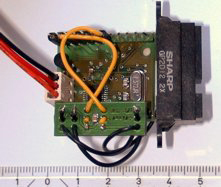Related Research Articles
Instrumentation is a collective term for measuring instruments, used for indicating, measuring, and recording physical quantities. It is also a field of study about the art and science about making measurement instruments, involving the related areas of metrology, automation, and control theory. The term has its origins in the art and science of scientific instrument-making.

IEEE 488, also known as HP-IB and generically as GPIB, is a short-range digital communications 8-bit parallel multi-master interface bus specification developed by Hewlett-Packard. It subsequently became the subject of several standards.
Zigbee is an IEEE 802.15.4-based specification for a suite of high-level communication protocols used to create personal area networks with small, low-power digital radios, such as for home automation, medical device data collection, and other low-power low-bandwidth needs, designed for small scale projects which need wireless connection. Hence, Zigbee is a low-power, low-data-rate, and close proximity wireless ad hoc network.

Electronic test equipment is used to create signals and capture responses from electronic devices under test (DUTs). In this way, the proper operation of the DUT can be proven or faults in the device can be traced. Use of electronic test equipment is essential to any serious work on electronics systems.

A data logger is an electronic device that records data over time or about location either with a built-in instrument or sensor or via external instruments and sensors. Increasingly, but not entirely, they are based on a digital processor, and called digital data loggers (DDL). They generally are small, battery-powered, portable, and equipped with a microprocessor, internal memory for data storage, and sensors. Some data loggers interface with a personal computer and use software to activate the data logger and view and analyze the collected data, while others have a local interface device and can be used as a stand-alone device.
Wireless sensor networks (WSNs) refer to networks of spatially dispersed and dedicated sensors that monitor and record the physical conditions of the environment and forward the collected data to a central location. WSNs can measure environmental conditions such as temperature, sound, pollution levels, humidity and wind.
Sensor web is a type of sensor network that heavily utilizes the World Wide Web and is especially suited for environmental monitoring. OGC's Sensor Web Enablement (SWE) framework defines a suite of web service interfaces and communication protocols abstracting from the heterogeneity of sensor (network) communication.
Power-system automation is the act of automatically controlling the power system via instrumentation and control devices. Substation automation refers to using data from Intelligent electronic devices (IED), control and automation capabilities within the substation, and control commands from remote users to control power-system devices.
Building automation (BAS), also known as building management system (BMS) or building energy management system (BEMS), is the automatic centralized control of a building's HVAC, electrical, lighting, shading, access control, security systems, and other interrelated systems. Some objectives of building automation are improved occupant comfort, efficient operation of building systems, reduction in energy consumption, reduced operating and maintaining costs and increased security.
SensorML is an approved Open Geospatial Consortium standard and an XML encoding for describing sensors and measurement processes. SensorML can be used to describe a wide range of sensors, including both dynamic and stationary platforms and both in-situ and remote sensors.
TransducerML or TML is a retired Open Geospatial Consortium standard developed to describe any transducer in terms of a common model, including characterizing not only the data but XML formed metadata describing the system producing that data.

Brake-by-wire technology in the automotive industry is the ability to control brakes through electronic means, without a mechanical connection that transfers force to the physical braking system from a driver input apparatus such as a pedal or lever.

A smart transducer is an analog or digital transducer, actuator, or sensor combined with a processing unit and a communication interface.

Daintree Networks, Inc. was a building automation company that provided wireless control systems for commercial and industrial buildings. Founded in 2003, Daintree was headquartered in Los Altos, California, with an R&D lab in Melbourne, Australia.

TTP/A is a time-triggered real-time fieldbus protocol used for the interconnection of low-cost smart transducer nodes. In contrast to the Time-Triggered Protocol (TTP), which is a high-speed, fault-tolerant communication network intended for safety critical applications, TTP/A provides a low-speed, low-cost protocol suitable for non-critical applications like car body electronics.

OCARI is a low-rate wireless personal area networks (LR-WPAN) communication protocol that derives from the IEEE 802.15.4 standard. It was developed by the following consortium during the OCARI project that is funded by the French National Research Agency (ANR):

An RF module is a (usually) small electronic device used to transmit and/or receive radio signals between two devices. In an embedded system it is often desirable to communicate with another device wirelessly. This wireless communication may be accomplished through optical communication or through radio-frequency (RF) communication. For many applications, the medium of choice is RF since it does not require line of sight. RF communications incorporate a transmitter and a receiver. They are of various types and ranges. Some can transmit up to 500 feet. RF modules are typically fabricated using RF CMOS technology.
A compact controller is a generic name given to a small autonomous controller which can control one or several control loops. They are also known as panel mounted, discrete, dedicated, or universal process controllers. The controllers can be easily configured and to control most types of control loop. Simple versions have a numerical display of the process values. Compact controllers in high-end equipment are available with touchscreen and graphical representation of the control loop or the system.
References
- ↑ "An Overview of IEEE 1451.4 Transducer Electronic Data Sheets (TEDS)" (PDF). IEEE . Retrieved 22 June 2021.
- ↑ IEEE Standard for a Smart Transducer Interface for Sensors and Actuators. IEEE Standards Association. doi:10.1109/IEEESTD.2007.4346346. ISBN 978-0-7381-5599-9.